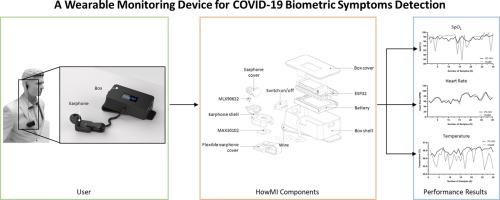IRBM ( IF 4.8 ) Pub Date : 2023-10-27 , DOI: 10.1016/j.irbm.2023.100810 Claudino Costa , João M. Faria , Diana Guimarães , Demétrio Matos , António H.J. Moreira , Pedro Morais , João L. Vilaça , Vítor Carvalho

|
Background
Monitoring COVID-19 symptoms has become a critical task in controlling the spread of the virus and preventing hospitalizations. Aiming to contribute to efficient monitoring solutions, this article presents the development and testing of a wearable device capable of continuous monitoring biometric signals associated with the presence of COVID-19, such as the heart rate, the blood oxygen saturation, and the body temperature.
Methods
To ensure continuous monitoring the device is designed to be worn in the ear. Here, the temperature is measured through a non-contact infrared temperature sensor placed inside the ear canal while the heart rate and the pulse oximetry signals are monitored through a photoplethysmography reflective sensor positioned at the earlobe.
The proposed device's performance was evaluated by comparing it against a medical certified station. Usability and ergonomics were assessed through users' questionnaires. Additionally, experiments were performed to evaluate the hearing loss when the proposed device is in use. Data was acquired from 30 individuals of different sex, aged between 20 and 43 years old. In relation to usability and ergonomics the variation in ear dimensions was accessed and related to the device's comfort limitations.
Results
The temperature measurement produced a moderate correlation (), despite a higher standard deviation was found in the proposed solution. This is due to the limited variability in temperature data, creating a short measuring range, as only healthy people were tested. The heart rate measurement also showed good correlation (), with the proposed solution showing good repeatability with a standard deviation of 6.06 BPM, however, the SpO2 measurement was suboptimal ().
The ergonomic evaluation revealed that most participants found the device shape comfortable, but some found the dimensions not adequate.
Additionally, the device was found to be user-friendly, with most participants reporting that they found it to be intuitive, and none reported a major loss in hearing in a normal conversation, however, there's a negligible loss of approximately 0.56 dB.
Conclusions
During this study, it was possible to develop and evaluate a wearable device that was suggested for monitoring biometric signals. The device demonstrated great reliability in temperature and heart rate measurement but showed limitations in the accuracy of pulse oximetry. The main contribution of this work is the evaluation of a continuous non-invasive monitoring concept for COVID-19 related biometric signals, which indicates good applicability in the case study.
中文翻译:

用于检测 COVID-19 生物特征症状的可穿戴监测设备
背景
监测 COVID-19 症状已成为控制病毒传播和防止住院的一项关键任务。本文旨在为高效的监测解决方案做出贡献,介绍了一种可穿戴设备的开发和测试,该设备能够连续监测与 COVID-19 存在相关的生物识别信号,例如心率、血氧饱和度和体温。
方法
为了确保持续监测,该设备被设计为佩戴在耳朵中。这里,通过放置在耳道内的非接触式红外温度传感器测量温度,同时通过位于耳垂的光电体积描记反射传感器监测心率和脉搏血氧饱和度信号。
通过与医疗认证站进行比较来评估所提出的设备的性能。通过用户问卷调查评估可用性和人体工程学。此外,还进行了实验来评估使用所提出的设备时的听力损失。数据来自 30 名不同性别、年龄在 20 岁至 43 岁之间的个体。在可用性和人体工程学方面,耳朵尺寸的变化与设备的舒适度限制有关。
结果
温度测量产生了中等相关性(),尽管在建议的解决方案中发现了更高的标准偏差。这是由于温度数据的可变性有限,测量范围较短,因为仅对健康人进行了测试。心率测量也显示出良好的相关性(),建议的解决方案显示出良好的重复性,标准偏差为 6.06 BPM,但是 SpO2 测量结果并不理想()。
人体工学评估显示,大多数参与者认为设备形状舒适,但也有一些参与者认为尺寸不够。
此外,该设备用户友好,大多数参与者报告说他们发现它很直观,没有人报告正常对话中听力出现重大损失,但是,大约 0.56 dB 的听力损失可以忽略不计。
结论
在这项研究中,可以开发和评估用于监测生物特征信号的可穿戴设备。该设备在温度和心率测量方面表现出极高的可靠性,但在脉搏血氧测定的准确性方面表现出局限性。这项工作的主要贡献是评估了 COVID-19 相关生物识别信号的连续无创监测概念,这表明在案例研究中具有良好的适用性。



























 京公网安备 11010802027423号
京公网安备 11010802027423号